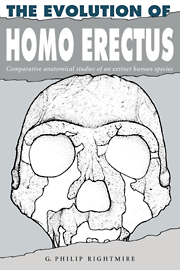Book contents
- Frontmatter
- Contents
- Preface
- 1 Introduction
- 2 Homo erectus in the Far East
- 3 Homo erectus at Olduvai Gorge
- 4 Discoveries from the Turkana basin and other localities in sub-Saharan Africa
- 5 Northwest Africa
- 6 Comparisons of African hominids with Asian Homo erectus
- 7 Homo erectus as a paleospecies
- 8 The transition to more modern forms
- 9 Summary and prospects for further research
- References
- Author index
- Subject index
6 - Comparisons of African hominids with Asian Homo erectus
Published online by Cambridge University Press: 14 October 2009
- Frontmatter
- Contents
- Preface
- 1 Introduction
- 2 Homo erectus in the Far East
- 3 Homo erectus at Olduvai Gorge
- 4 Discoveries from the Turkana basin and other localities in sub-Saharan Africa
- 5 Northwest Africa
- 6 Comparisons of African hominids with Asian Homo erectus
- 7 Homo erectus as a paleospecies
- 8 The transition to more modern forms
- 9 Summary and prospects for further research
- References
- Author index
- Subject index
Summary
In the four preceding chapters, I have provided descriptive accounts of the morphology of fossils from Java, Olduvai Gorge, other East African localities and northwest Africa. These descriptions are in some cases quite detailed. Where appropriate, I have incorporated comparative information, including at least some discussion of general resemblances among specimens from a given site or geographic area. It should be apparent that a number of the individuals from Trinil, Sangiran and Sambungmachan are broadly similar. Particularly the larger crania from Sangiran and Sambungmachan also share features with the assemblage from Ngandong, although there are some differences. So far, I have taken the position that all of these Javanese hominids can be referred to Homo erectus.
The large braincase found by Louis Leakey in deposits of upper Bed II at Olduvai seems unequivocally to represent the same species. This has been emphasized in earlier reports (Rightmire, 1979), although OH 9 has not before been compared systematically to specimens from Indonesia. The most complete of the Olduvai mandibles also shows similarities to Asian Homo erectus (Rightmire, 1980), as do the jaws from Ternifine (Arambourg, 1963). Other remains from East Africa are perhaps less easily identified by species. Doubt concerning the affinities of the two rather complete crania from East Turkana has been expressed recently by Wood (1984).
- Type
- Chapter
- Information
- The Evolution of Homo ErectusComparative Anatomical Studies of an Extinct Human Species, pp. 138 - 179Publisher: Cambridge University PressPrint publication year: 1990



